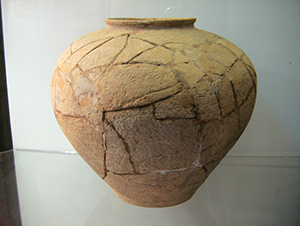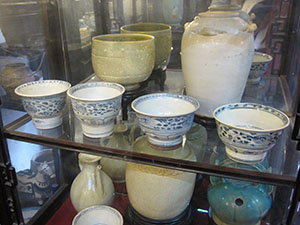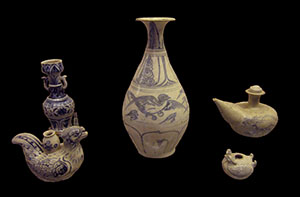|
|
|
|
Vietnamese ceramics refers to pottery designed or produced in Vietnam. Vietnamese pottery and ceramics has a long history spanning back to thousands of years ago, including long before Chinese domination, as archeological evidence supports. Much of Vietnamese pottery and ceramics after the Chinese-domination era was largely influenced by Chinese ceramics, but has developed over time to be distinctly Vietnamese. Vietnamese potters combined indigenous and Chinese elements. They also experimented with both original and individual styles as well as incorporated features from other cultures, such as Cambodia, India and Champa. Vietnamese pottery and ceramics were an essential part of the trade between Vietnam and its neighbors during feudalistic times, throughout many dynasties.
|
|
|
|
|
Cát Tiên The Cát
Tiên archaeological site in south Vietnam is site
located in Cat Tien National Park. Accidentally
discovered in 1985, this
site ranges from Quảng Ngãi Commune to Đức Phổ Commune,
with the main
archaeological artefacts concentrating in Quảng Ngãi,
Cát Tiên District,
Lâm Đồng Province, southern Tây Nguyên. The unknown
civilization which
developed this site inhabited it between the 4th century
and 9th
centuries CE. |

Mộ vò gốm, a ceramic burial jar from Cát Tiên in south Vietnam (4th-9th century CE)
|
|
|
|
|
Bát Tràng
Bát Tràng porcelain and pottery is a type of ceramics made in
the village of Bát Tràng, in the suburban outskirts of Hanoi. The
village is located in an area rich in clay suitable for making fine
ceramic. Bát Tràng ceramics are considered some of the best known
porcelain products in Vietnam besides those of Chu Đậu, Đồng Nai, Phu
Lang, and Ninh Thuận. The history of china making in this village can be
traced back as far as the 14th century CE. During the past centuries,
Bát Tràng china products have travelled in European trading ships to all
parts of the world.
|
|
|
|
|
An'nan
Due to the so-called Nanban trade (hán tự: 南蛮貿易) in the
16th-17th century, fragments of Vietnamese ceramic were found in a
northern part of Kyūshū island. Among them was a wooden plate with
character showing the date 1330 on it. Whether the Japanese went to
Vietnam or Vietnamese traders came to Japan or if it all went through
China is not quite clear. Vietnamese history records showed that when
Lord Nguyễn Hoàng founded Hội An port at the beginning of the 17th
century, hundreds of Japanese residents were already there.
One of the more famous items is An'nan ware (安南), which
was
exported to Japan and used in Japanese tea ceremony
although the
high-footed bowls were originally used for food. The
bowls had an
everted rim, high foot, were underglazed with cobalt
floral decorations,
lappets above base, unglazed stacking rings in well and
were brown
washed on the base. The diameters can range from 9 to 15
centimetres.
They were produced from the 16-17th century CE. |

An'nan ware in blue and white
|
|
|
|
|
Hội An wreck
The Hội An wreck lies 22 miles off the coast of central Vietnam
in the South China Sea. The ship was carrying a large cargo of
Vietnamese ceramics from the mid- to late-15th century. The provenance
of the pieces was known to be the kilns of the Red River Delta (such as
Chu Đậu) because excavations in the region had been ongoing since their
discovery in 1983. The only pieces remaining at the kiln sites were
wasters (pieces that had fused, collapsed or exploded in the firing
process). Intact examples of the wares produced were rare, since all
were exported. When the wreck was found there was excitement among
collectors and archaeologists, for it promised the first cargo
consisting solely of Vietnamese wares. In 1996 over 250,000
intact examples of Vietnamese ceramic
were recovered. 10% of unique ware was kept by the
government for
national museums, while the rest was allowed to be
auctioned off to pay
for recovery costs. |

Blue and white ceramic lampstand, vase ewers in
phoenix shape dated to Early Lê dynasty, 15th century. Provenience Chu
Đậu kiln, Hải Dương province |
|
|
|
|
Modern ceramic
While ceramic ware in the traditional is still being produced
and enjoys popularity, increasingly modern ceramics are produced for
export. One of the noteworthy examples of modern ceramic art is the
Hanoi Ceramic Mosaic Mural, which is affixed on the wall of the dyke
system of Hanoi. With a length of about 4km, the Ceramic Road is one of
the major projects that were developed on the occasion of the Millennial
Anniversary of Hanoi. |
|
|
|
|
(From Wikipedia, the free encyclopedia) |
|
|
|
|
|
GIA HO TRADING & PRODUCTION CO., LTD
Office : 79/3 Road 12th, Tam Binh Ward, Thu Duc Dist., HCMC, VIETNAM
Tel : +84 540 313 80
Fax : +84 540 313 87
Email : export@giaho.com.vn
©2014 Copyright NGUYENCHI (IT Solution)
|
|
|